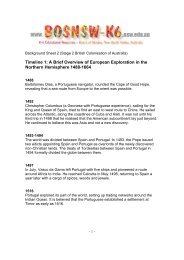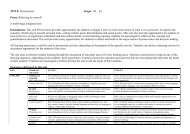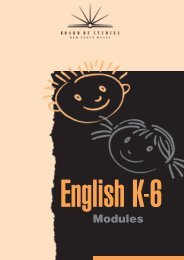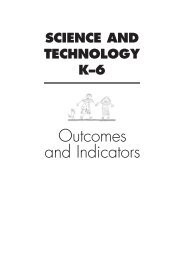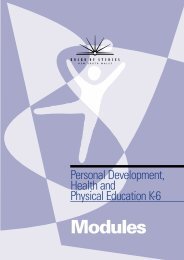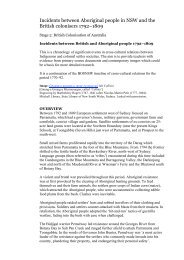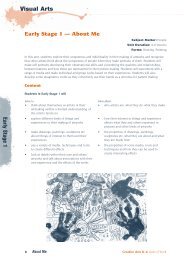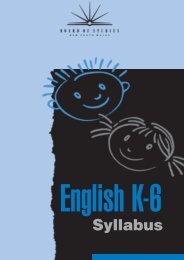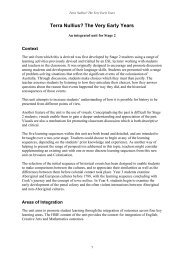Math K-6 WS - K-6 Educational Resources
Math K-6 WS - K-6 Educational Resources
Math K-6 WS - K-6 Educational Resources
Create successful ePaper yourself
Turn your PDF publications into a flip-book with our unique Google optimized e-Paper software.
<strong>Math</strong>ematicsK-6 Early Stage1<br />
WM<br />
What’s Wrong With this Pattern?<br />
Students are presented with patterns where one of the elements<br />
(eg shapes, pictures, letters, numbers) has been misplaced.<br />
eg ���������<br />
Possible questions include:<br />
❚ do you think this is a pattern?<br />
❚ can you find what is wrong and can you correct the<br />
mistake?<br />
Students should experience a variety of patterns with errors so<br />
that they can readily identify patterns that repeat and those<br />
that don’t.<br />
‘Is the Same as’<br />
Students are given collections of objects to sort and count in<br />
order to find groups that have the same number of objects.<br />
Students describe and label the group using the term ‘is the<br />
same as’.<br />
eg ��� is the same as<br />
���<br />
Students could use drawings or simple computer graphics, and<br />
the term ‘is the same as’ to record their findings.<br />
pattern blocks, unifix cubes, multilink cubes, coloured<br />
counters, lego or duplo bricks, a paper strip with numbers<br />
marked, calculators, calendar<br />
Links<br />
Whole Numbers<br />
Addition and Subtraction<br />
Multiplication and Division<br />
Time<br />
Sample Units of Work<br />
Connecting Repeating Patterns with Counting<br />
This activity has been included as a bridge to Stage 1 content.<br />
WM<br />
Part A<br />
Students are shown a large strip of paper with the numbers<br />
from 1 to 30 written on it. The paper is placed on the floor.<br />
Using materials, the teacher starts a repeating pattern with<br />
each new element of the pattern positioned above a number<br />
on the strip of paper.<br />
eg ∆ Ο ∆ Ο ∆ Ο ∆<br />
1 2 3 4 5 6 7 8 9<br />
Possible questions include:<br />
❚ can you describe the pattern I have made?<br />
❚ what part of the pattern repeats?<br />
❚ what will the next shape be? How do you know?<br />
Students are asked to imagine that the pattern continues and<br />
to consider the following questions:<br />
❚ what shape will be above the number 10? How do you<br />
know?<br />
❚ what shape will be above the number 15? How do you<br />
know?<br />
Extension: Students could be asked:<br />
❚ if we read out all of the numbers that have a circle above<br />
them, what do we know about these numbers?<br />
❚ if we continue the pattern up to the number 20, how<br />
many triangles will there be?<br />
Part B<br />
<strong>Resources</strong> Language<br />
26<br />
In pairs, students are given a numeral strip and a collection of<br />
objects to create a repeating pattern and pose questions to be<br />
answered by their partner.<br />
pattern, repeat, copy, is the same as, group, increase, decrease,<br />
before, after, next, wrong, ‘two’ pattern, ‘three’ pattern,<br />
number, count forwards, count backwards



